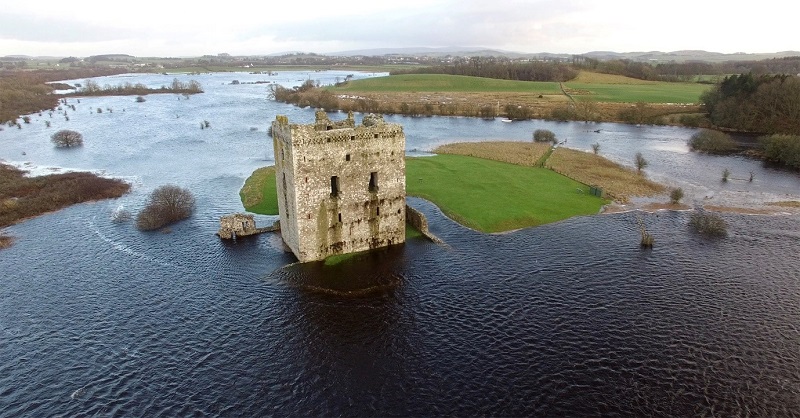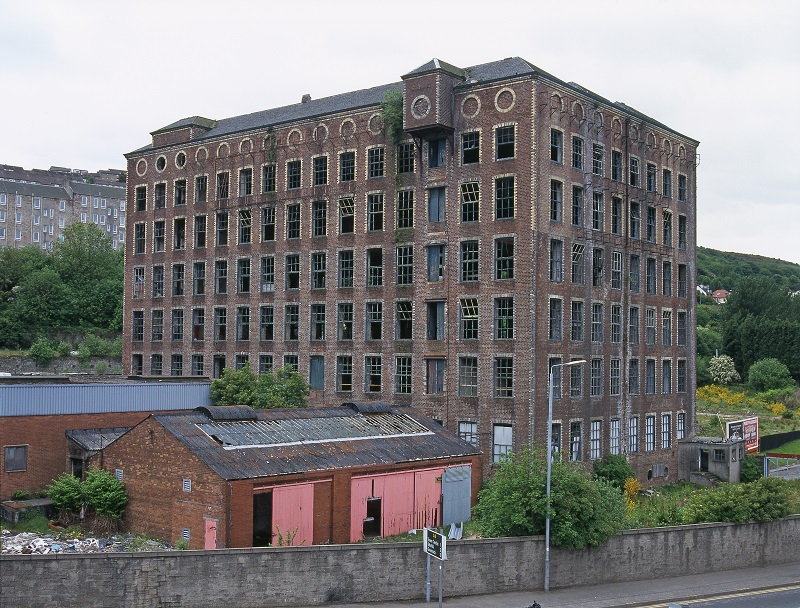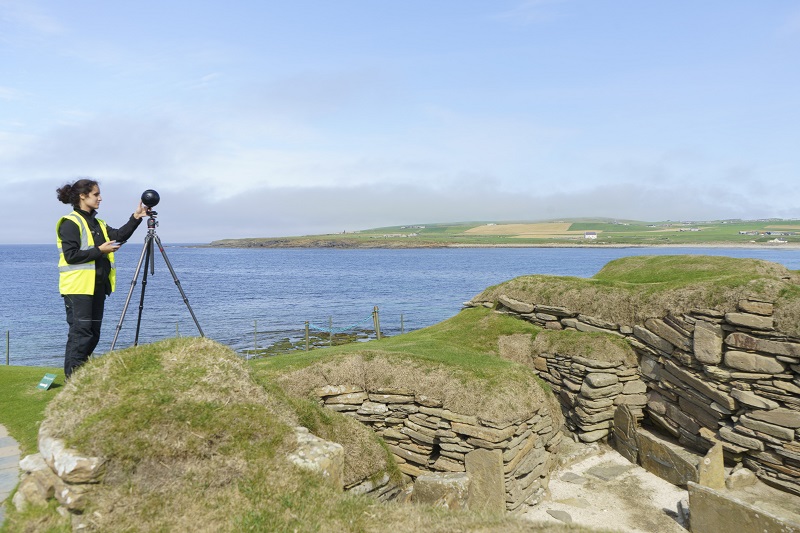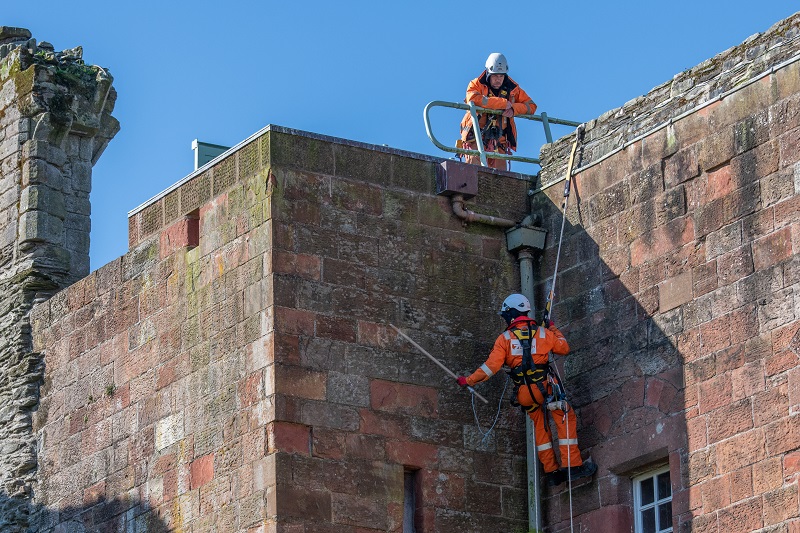How can we help the historic environment cope with climate change?
Climate Change, Conservation | Written by: Jennifer Farquharson | Thursday 30 November 2023

Threave Castle, located on an island in the River Dee. Although the castle itself is standing up well to increasing flooding events (as it was designed to make use of natural defences), other archaeological remains on the island have been lost.
Climate change affects the historic environment through a chain of events. Human activity in daily life, business, industry, travel and consumer behaviour releases greenhouse gases into the atmosphere.
These gases cause changes to our climate like warmer, wetter winters, hotter, drier summers, warmer oceans, and more extreme weather events, and in turn, these events influence how and when natural hazards occur. For example, the impact of climate change on sea levels and rainfall patterns increases the frequency and severity of floods, putting buildings and the materials they’re made from under stress.
Following our Impacts of Climate Change on Heritage event, which took place at the Engine Shed on Thursday 2 November, in this blog you can learn about some of the specific risks to historic buildings and landscapes from climate change, and discover how we can protect heritage amidst the climate emergency.
Why does climate change pose such a risk to buildings now?
Climate change is not a new phenomenon. Our climate has never been static. Natural, predictable cycles (like the path of the earth’s orbit and levels of activity in the sun) influence changes in our climate.
However, we know these cycles are not responsible for the rate at which our planet is warming today. The direct influence of humans is.
A certain level of greenhouse gases in the atmosphere is essential for earth to be a habitable place to live. It would be too cold for life as we know it to exist without them. But our dependence on fossil fuels like coal and natural gas since the Industrial Revolution has resulted in unprecedented levels of greenhouse gases.
You can see the impacts of climate change over the decades on BBC infographics.

Gourock Rope works factory. Buildings like these are now an important part of our Industrial Heritage, but research has shown that large-scale industry which began during the Industrial Revolution has impacted on our climate.
As a result, climate change is happening at an accelerated rate and our buildings are struggling to cope. They need our help, through maintenance, repair and adaptation, more than ever.
What can we do to help traditional buildings?
Survey buildings for signs of decay
Traditional buildings are at risk of decaying and deteriorating at a faster rate because of climate change, which is causing increased rainfall. Research shows that annual precipitation levels have increased by over 20%. Water is a major agent of decay in buildings. If water can’t move through any of the materials used to construct a traditional building, it’ll get trapped. This can cause various issues which damage the very structure of materials and puts the whole building at risk.
These issues include:
- encouraging organisms to grow inside the stone
- letting in salt from rainwater or sea spray
- allow trapped water to go through freeze-thaw cycles
It’s not just increased rainfall that poses a risk to buildings. More extreme weather, like storm winds or higher temperatures, can erode or weaken mortar and stonework more quickly, especially in buildings more exposed to the elements.
What to inspect
That’s why it’s important to survey buildings and check for any damage. Regularly monitoring whole buildings means issues caused by climate change can be spotted and addressed more quickly. Areas to inspect include:
- roofs
- chimneys and flues
- rainwater goods (like gutters)
- external and internal walls
- openings (like doors and windows)
Our free building advice has lots of tips on keeping traditional (pre-1919) buildings in good shape.
Prepare for extreme weather

Senior Digital Innovation Officer, Sophia Mirashrafi, digitally documenting Skara Brae.
Extreme weather has had a major impact on Scotland’s historic places. In August 2022, several Scottish cities saw electrical storms and flash flooding. Even tornadoes have been spotted in parts of Scotland, including Roslin. In summer 2023, Cannich, near Inverness saw wildfires of up to 24 square miles due to high temperatures.
Extreme weather causes issues like instability through ground movement, physical damage to buildings, and a greater risk of decay from oversaturation or biological growth. But there are actions we can take to lessen the strain of extreme weather on our buildings:
- maintain and monitor underground draining and adapt surface drainage
- improve rainwater systems and weathering details
- inspect, maintain and repair buildings more regularly including: repointing masonry, applying appropriate external coatings, adding additional fastenings to ridges and slates etc
- get appropriate advice from reliable sources on storm-proofing traditional buildings and other repair and maintenance issues
Monitoring traditional buildings is incredibly important in the face of climate change. As part of our Citizen Science project, Monument Monitor, we are able to use the photographs visitors take at our sites and then share with us, to monitor any changes, establish how climate change is affecting them, and create learning models. Learn more about Citizen Science in our Inform Guide.
Prepare for rising sea levels

High level maintenance work being carried out at Rothesay Castle.
Rising sea levels and coastal erosion are putting historic sites like Skara Brae and Fort George at real risk. Around 8% of the sites we care for at Historic Environment Scotland are within 10 meters of the coastline.
Soft coasts (those made up of soft rocks) form around 19% of Scotland’s coastline, and research by Scotland’s Centre of Expertise for Waters [PDF, 1659KB] found they are eroding at an average rate of 0.43 m/yr, with coastal erosion now affecting 46% of the soft coast, an increase over the 38% identified in 2017.
We have to understand rising sea levels in order to be able to prepare for them. To protect coastal heritage, we can install measures like sea defences, which have been in place at many of our sites for several years. But sea defences need to be regularly monitored and maintained.
Recording coastal heritage is also an important part of the conservation process. Digitally documenting sites, using laser scanning and photogrammetry creates an accurate 3D record of them to inform conservation decision making.
Find out more about the different data capture techniques that can be used to analyse, conserve and visualise historic sites in our Short Guide to Applied Digital Documentation.
Explore our free literature on climate change, impacts, and adaptation:
About the author:
Jennifer Farquharson
Jennifer Farquharson is a Content Officer at the Engine Shed. Jen creates engaging content about our sustainable conservation centre.
View all posts by Jennifer Farquharson



